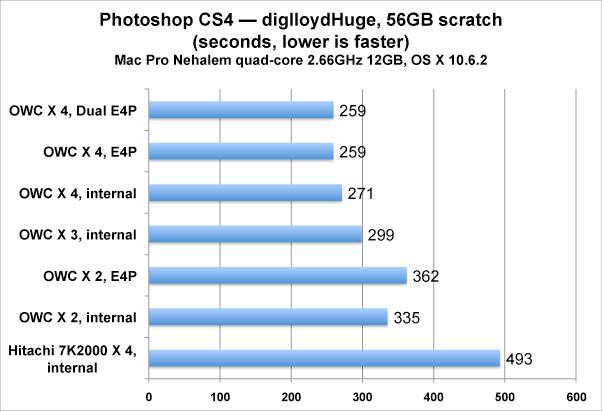...I just read the graph as one would read a piece of text. It has enough information there to understand at a glance given the brief introduction and to get a sense of the matter..
Sorry to still disagree, I will stop arguing after this post I promise

. IMO "enough information" can easily become "misinformation" if one interprets is wrongly. By looking at this graph, and without reading the test details, I do not have any information about the following aspects of the test results:
- What is a diglloydHuge benchmark
- What raid configurations were deployed for the SSD array and for the HD array
- To what kind of raid controllers they were attached
- Where did one install the OS on, SSD or on HD (for each of the test configurations indicated)
- Which Hitachi hard disks and the capacity, just 7200 rpm is not enough info
- What is the capacity of the the SSD drives
- What other tasks were running in the background
- Whether the scratch disks have been "polluted" normally by using them in a CS4 production environment or were pristine
To me it's pretty clear that the SSD used in the circumstances of the test was very fast. If it degrades to 70% of that, so what, in a year it will be superceded and we'll recycle it anyway!
My point precisely; the circumstances of the test! That is what makes the results meaningful. If one would test the drives for a very subjective performance indicator which is not very important, and one would then present the results saying that the SSD array performs better, would it prove that SSD drives are definitely better? I don't think so.
In the meantime I have read about the diglloydHuge benchmark and it seems that it is a test script for CS4 which manipulates a 40,000 pixel wide image and creates a 56GB scratch file as a result. This is the most extreme situation whereby an SSD would win hands down from a HD, no discussions about it. But the time difference when working with our usual 5000 pixel wide images on a day-to-day basis will be less. Does it then justify investing 2000-3000 $ in the SSD array? I don't think so. I know I can invest that money much more wisely for real improvements to my workflow and the bottom line. And finally, I would not consider writing off such a huge investment after a year or so because the SSD drives have gone belly up.
Again: I agree with the added value of deploying SSD drives for the OS and the apps. The high investment is the only reason I haven't done that just yet. But I would never deploy SSD drives as a scratch disk unless the next gen SSD technology comes with improved lifecycles. That's all I wanted to say from the beginning.

Cheers,

